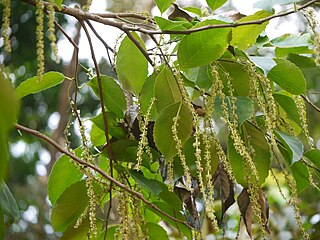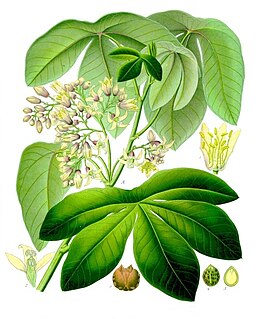
A plum is a fruit of some species in Prunus subg. Prunus. Mature plum fruits may have a dusty-white waxy coating that gives them a glaucous appearance. This is an epicuticular wax coating and is known as "wax bloom". Dried plums are called prunes, which have a dark, wrinkled appearance.

Ginkgoales is a gymnosperm order containing only one extant species: Ginkgo biloba, the ginkgo tree. It is monotypic, within the class Ginkgoopsida, which itself is monotypic within the division Ginkgophyta. The order includes five families, of which only Ginkgoaceae remains extant.

The Piperaceae, also known as the pepper family, are a large family of flowering plants. The group contains roughly 3,600 currently accepted species in 5 genera. The vast majority of species can be found within the two main genera: Piper and Peperomia.

Aeonium, the tree houseleeks, is a genus of about 35 species of succulent, subtropical plants of the family Crassulaceae. Many species are popular in horticulture. The genus name comes from the ancient Greek "αιώνιος"/"aionios" (ageless). While most of them are native to the Canary Islands, some are found in Madeira, Morocco, and in East Africa.

Lycopodium clavatum is the most widespread species in the genus Lycopodium in the clubmoss family.

Ulmus crassifoliaNutt., the Texas cedar elm or simply cedar elm, is a deciduous tree native to south central North America, mainly in southern and eastern Texas, southern Oklahoma, Arkansas and Louisiana, with small populations in western Mississippi, southwest Tennessee and north central Florida; it also occurs in northeastern Mexico. It is the most common elm tree in Texas. The tree typically grows well in flat valley bottom areas referred to as 'Cedar Elm Flats'. The common name 'cedar elm' is derived from the trees' association with juniper trees, locally known as cedars.

Pandanaceae is a family of flowering plants native to the tropics and subtropics of the Old World, from West Africa through the Pacific. It contains 982 known species in five genera, of which the type genus, Pandanus, is the most important, with species like Pandanus amaryllifolius and karuka being important sources of food. It is an ancient family dating from the early to mid-Cretaceous. This is a family that is not-well studied.

The genus of the myrrhs, Commiphora, is the most species-rich genus of flowering plants in the frankincense and myrrh family, Burseraceae. The genus contains approximately 190 species of shrubs and trees, which are distributed throughout the (sub-) tropical regions of Africa, the western Indian Ocean islands, the Arabian Peninsula, India, and Vietnam. The genus is drought-tolerant and common throughout the xerophytic scrub, seasonally dry tropical forests, and woodlands of these regions.

Magnolia champaca, known in English as champak, is a large evergreen tree in the family Magnoliaceae. It was previously classified as Michelia champaca. It is known for its fragrant flowers, and its timber used in woodworking.

Epipogium aphyllum, the ghost orchid is a hardy myco-heterotrophic orchid lacking chlorophyll.

Homalium is a genus of plants in the family Salicaceae.

Vallea is a genus of trees in the family Elaeocarpaceae. Trees in this genus are native to the Andes mountain range in South America and are classified in two species:
Flora of China is a scientific publication aimed at describing the plants native to China.

Rhododendron simiarum, the South China rhododendron, is one of the many species of the genus Rhododendron, which mainly grows in Southern China. The species has also developed a habitat in Hong Kong, being one of the six native species of rhododendrons grown in Hong Kong, commonly found in the slopes of Ma On Shan, and Lantau Island. It is also distributed in Hainan, Guangdong, Guangxi, Hunan, Jiangxi, Fujian, Zhejiang.
Ancylostoma ceylanicum is a parasitic roundworm belonging to the genus Ancylostoma. It is a hookworm both of humans and of other mammals such as dogs, cats, and golden hamsters. It is the only zoonotic hookworm species that is able to produce symptomatic infections in humans, with the majority of cases being in Southeast Asia.

Manihot carthaginensis subsp. glaziovii, also known as Manihot glaziovii, the tree cassava or Ceara rubber tree, is a species of deciduous flowering plant in the spurge family, Euphorbiaceae, that is native to eastern Brazil.
Hypericum acmosepalum is a dwarf shrub in Hypericumsect. Ascyreia that is native to China and known as jian e jin si tao locally.

Orthotrichum lyellii, also known as Lyell's bristle moss, is a species of acrocarpous moss belonging to the family Orthotrichaceae. O. lyellii can be found throughout western North America and Europe. It is found most commonly growing epiphytically on a variety of trees, and less commonly on rocks or boulder substrates.
Homalium brevidens is a shrub or tree species in the family Salicaceae, found in Laos and Cambodia.















